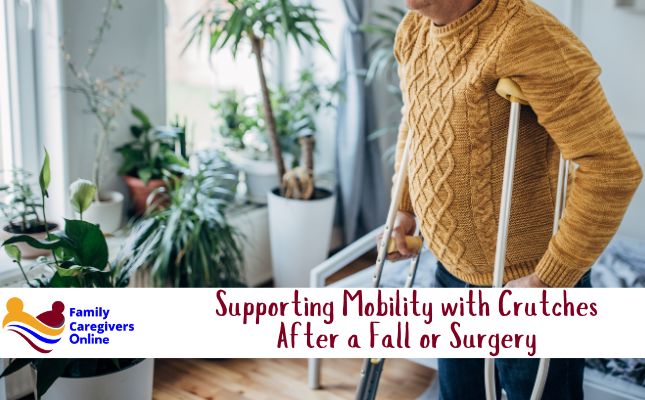


Falls are all too common among older adults, which is why one of the first questions healthcare providers ask is, “Have you fallen in the last month or year?” While many falls result in only minor bruises, others can lead to more serious injuries, sometimes requiring the use of crutches or other mobility aids. Crutches are also commonly prescribed after foot, leg, or ankle surgeries, even if just for a few weeks.
Whether due to an injury or surgery, limited leg mobility can make daily tasks, like walking or climbing stairs, challenging. Your care recipient may not always ask for help, but that doesn’t mean they don’t need it. They may be trying to manage on their own, quietly struggling. While recovery takes time, using crutches correctly can support healing, reduce the risk of falls, and help maintain a sense of independence.


Learning to Use Crutches
Crutches often feel awkward at first, and using them incorrectly can lead to discomfort or even injury. Most hospitals provide a brief tutorial before discharge. This training may not be adequate, especially when you are handling the details of discharge and helping your care receiver safely into the car. Watching reputable video tutorials from physical therapists or hospital systems on YouTube can also provide helpful, step-by-step guidance. Practice using the brief instructions here and the provided infographic at home. An important benefit of learning how to work with crutches is that it helps build confidence for you and your care receiver. Confidence leads to increased safety.
Crutch Safety Basics at Home
Proper Fit and Posture
-
Crutch tops should be 1 to 1½ inches below the armpits, not touching them.
-
Hand grips should align with the hips, allowing the elbows to stay slightly bent.
-
Position the crutch tips a few inches to the side of each foot to avoid tripping.
-
Always support the weight with the hands, not the armpits, to prevent nerve damage.
How to Walk with Crutches
-
Move both crutches forward 6 to 12 inches.
-
Step forward with the injured or weaker leg.
-
Bring the stronger leg forward, passing the crutches.
-
Keep the body upright and eyes looking ahead (not down).
-
Walk slowly and with control—no rushing.
Navigating Stairs and Slippery Areas
-
Use ramps or elevators whenever possible.
-
Going upstairs: Step up first with the strong leg, then bring up the injured leg and crutches.
-
Going downstairs: Place crutches down first, move the injured leg forward slightly, then step down with the strong leg.
-
Avoid wet or slick floors, and wear non-slip shoes with good support.
Extra Tips for Success
-
Use a sturdy chair with armrests to make sitting and standing easier.
-
Practice using crutches in a safe, open area before attempting to navigate stairs or uneven ground.
-
Check the rubber tips on the crutches daily and replace them if they’re worn or slippery.
-
Don’t hesitate to ask a physical therapist or doctor for help, especially if your care receiver has balance issues or additional health conditions.
A Final Note
Using crutches may be temporary, but it’s a big adjustment. Your support as a caregiver, guide, and cheerleader can make all the difference. Encourage rest, celebrate progress, and remember to take care of yourself along the way.
By Zanda Hilger, LPC, Founder, Family Caregiver & Program Manager for Family Caregivers Online
Sources: How to use crutches in any situation Healthline; Using crutches: MedlinePlus Medical; YouTube Using crutches going upstairs and downstairs Brattleboro Memorial Hospital
We hope this information is helpful to you in the important work you do as a family caregiver.
For more resources, subscribe to our free newsletter!








